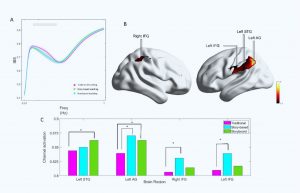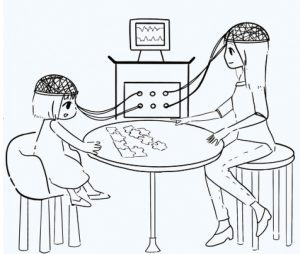In recent years, the focus of research on child development and early education has shifted from simply measuring academic and developmental outcomes to exploring the processes behind them. At the heart of both learning and development is social interaction, a central concept in many psychological theories, such as Vygotsky’s sociocultural theory and Bronfenbrenner’s ecological systems theory. By analysing the psychological mechanisms involved in these interaction processes, we can gain a deeper understanding of their role in children’s learning and development, and study how the brain processes learning and social interaction. These studies not only provide empirical evidence to support these psychological theories but also help identify the neural pathways involved, enabling us to develop more targeted educational strategies and interventions that enhance child development.
Brain Synchronisation and Educational Outcomes
In recent years, scientists have used advanced neuroimaging techniques, such as functional near-infrared spectroscopy (fNIRS) hyperscanning, to explore the influence of brain synchronisation (also known as inter-brain synchrony) on both educational experiences and family dynamics. Brain synchrony refers to the state in which two or more individuals (such as a student and a teacher) exhibit significant synchrony in brain activation patterns in specific regions of the brain during social interactions, a phenomenon called ‘inter-brain neural coupling’.
Our research group has used fNIRS hyperscanning to observe, in real time, the brain activity of children and adults during learning and family interactions. The aim is to investigate the role of brain synchronisation in children’s interactions with their social environment. Our research findings not only reveal how enhancing educational and parenting practices can improve developmental outcomes at the neural level, but also highlight the importance of interpersonal brain synchronisation as a reliable indicator for assessing the quality of children’s interactions with their social environment.
Story-Based Teaching: Enhancing STEM Learning at the Neural Level
STEM (science, technology, engineering, and mathematics) education is crucial for children’s future academic development, but identifying the most effective teaching methods for these critical subjects remains a challenge. Our research group investigated how three different teaching approaches—traditional lecturing and more engaging, creative methods (storytelling using picture books and storyboards)—in STEM educational settings affect brain synchronisation between students and teachers in STEM learning environments.
The results of our study show that in the storytelling condition, brain synchronisation between the left and right inferior frontal gyrus (IFG)—regions involved in language and information processing—was significantly higher than in the traditional lecture condition. Storytelling, with its narrative structure and emotional engagement, appeared to promote greater brain synchronisation between the teacher and the student. Similarly, when storyboards were used, increased synchronisation was observed in the superior temporal gyrus (STG), a region associated with the processing of auditory and visual information. This suggests that visual storytelling tools such as storyboards may enhance the brain’s ability to integrate and retain STEM concepts.
In addition, our study revealed a strong relationship between brain synchronisation and learning outcomes. In the storytelling condition, synchronisation in the left supramarginal gyrus (SMG)—a region crucial for processing sensory information and integrating it into understanding—was positively correlated with improved STEM learning outcomes. Therefore, the degree of brain synchronisation between students and teachers not only directly affects the effectiveness of information absorption, but also serves as a key indicator of learning outcomes. This finding reveals a key mechanism in the learning process and opens up new avenues for improving teaching practices in the classroom.
How Family Dynamics Influence Child Development
In another study, we observed the performance of 47 mother-daughter pairs in a jigsaw puzzle task to investigate how positive and negative parental feedback affects brain synchronisation between mothers and daughters, and to better understand children’s neural responses when interacting with their parents.
The study showed that negative feedback significantly reduced brain synchronisation between mothers and daughters in areas such as the left dorsolateral prefrontal cortex (dlPFC) and right inferior frontal gyrus (IFG), which are crucial for regulating emotions and processing social interactions. In other words, negative feedback may disrupt the neural pathways that help children process and cope with emotional experiences. In contrast, positive feedback was associated with increased synchronisation in these regions, suggesting that encouraging feedback helps mothers and daughters understand each other better during interactions.
We also found that families with a ‘conformity communication pattern’—defined by rigid, authoritarian communication—showed less synchronisation in brain areas related to emotional regulation and language processing. In contrast, families with a more open and conversational communication style exhibited greater synchronisation, suggesting that warmth and flexibility in communication support better emotional and cognitive development in children.
Notably, emotionally resilient children maintained strong brain synchronisation with their mothers, even when they received negative feedback. This suggests that resilience may buffer against the negative neural effects of criticism, helping children cope with challenges more effectively, both in terms of information processing and emotional regulation.
Bridging Science and Practice
Using advanced fNIRS hyperscanning technology, our studies have demonstrated the strong connection between brain synchronisation and both academic learning and emotional development, both in the classroom and at home. For educators, adopting more creative and engaging teaching methods such as storytelling and storyboarding can enhance brain synchronisation and improve learning outcomes. For parents and caregivers, understanding how different types of feedback affect brain synchronisation can help develop nurturing and effective strategies to support children’s emotional and cognitive growth. Overall, our studies pave the way for future research to explore the complex relationships between brain activity, social engagement, and developmental outcomes.
About the author(s)
Zhang Juan is an associate professor in the Faculty of Education, director of the Centre for Early Childhood Education and Child Development, and a member of the Centre for Cognitive and Brain Sciences at the University of Macau.
Kira Wang Yihui is a PhD student in the Faculty of Education at the University of Macau, under the supervision of Prof Zhang Juan.
Text & Photo: Zhang Juan, Kira Wang Yihui
Source: UMagazine ISSUE 31
Academic Research is a contribution column. The views expressed are solely those of the author(s).


